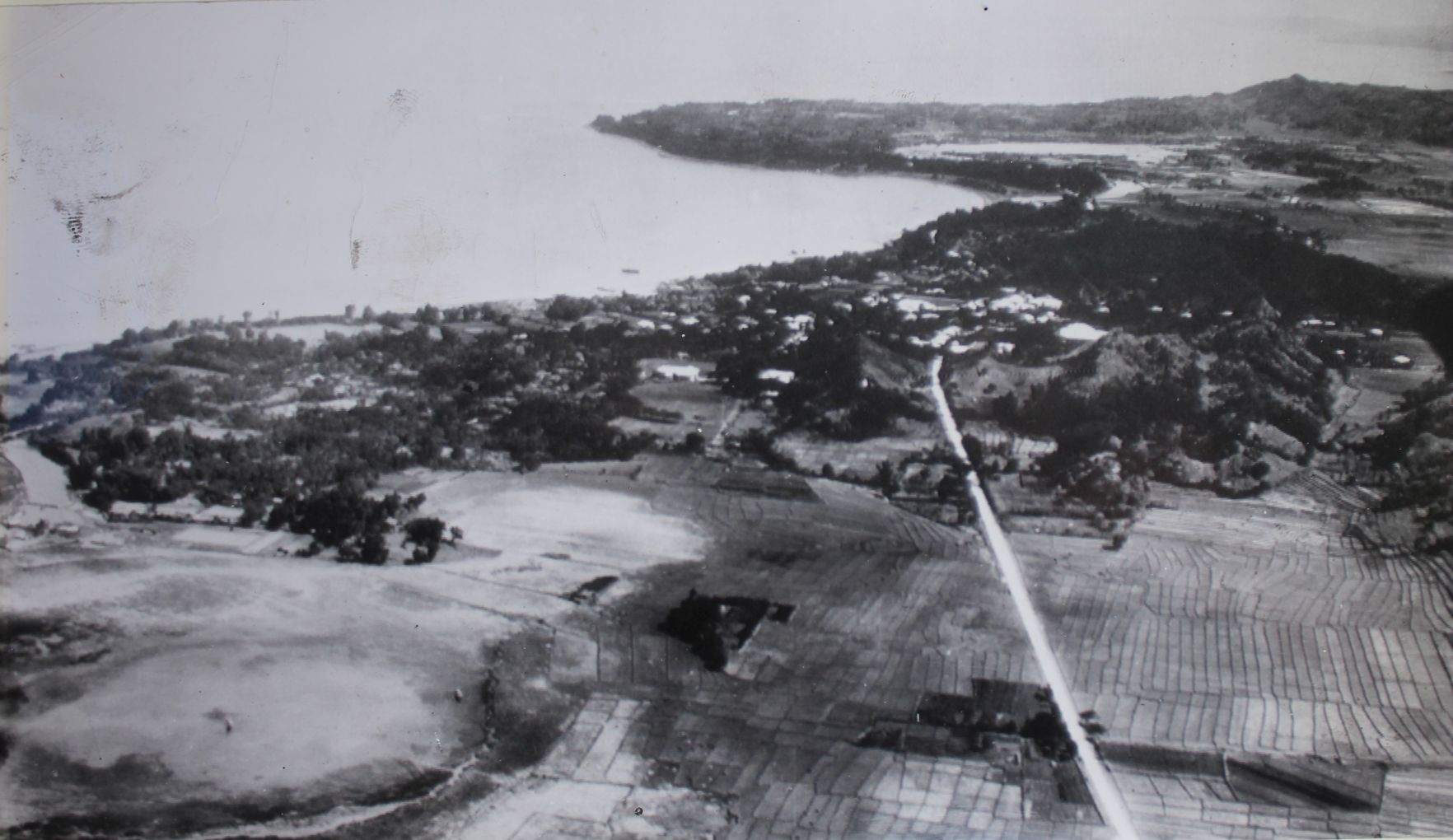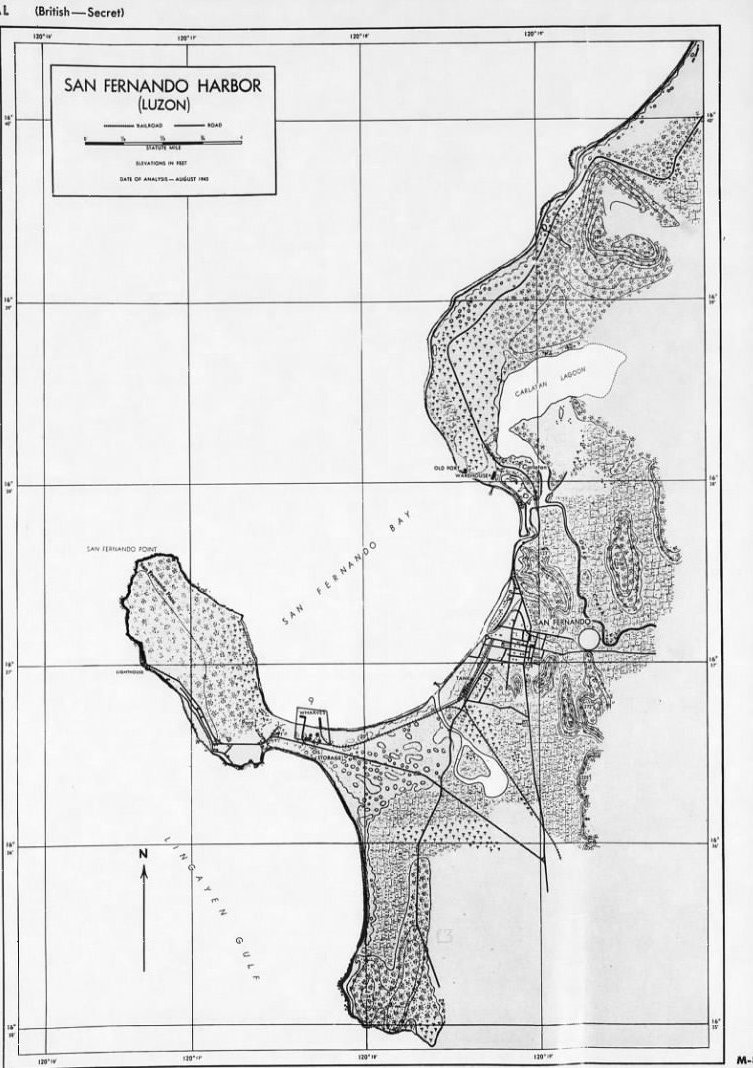
Zf848. To me this is the best picture of the bunch, it shows the whole San Fernando, La Union area and the authors marked the picture with the relevant geographic points and the timeline of the transshipment of the POWs in Dec. 1944.
—————————————————–
The horrendous tale and time table of the Allied POWs in the hands of the Japanese on the Oryoku Maru in 1944.
The following paragraphs were copied from Wikipedia page, click here:
This story needs to be retold and retold so people never forget this inhumane story!
Oryoku Maru left Manila on December 13, 1944, with 1,620 prisoners of war (including 1,556 American, 50 British and Dutch, 7 Czech, 4 Norwegians and several other nationalities) packed in the holds, and 1,900 Japanese civilians and military personnel in the cabins. Wikipedia.
USS Hornet attacked the unmarked ship, causing it to sink on December 15. About 270 died aboard ship. Some died from suffocation or dehydration. Others were killed in the attack, drowned or were shot while escaping the ship as it sank in Subic Bay where the ‘Hell Ship Memorial’ is located. A colonel, in his official report, wrote:
Many men lost their minds and crawled about in the absolute darkness armed with knives, attempting to kill people in order to drink their blood or armed with canteens filled with urine and swinging them in the dark. The hold was so crowded and everyone so interlocked with one another that the only movement possible was over the heads and bodies of others
The survivors of the sinking were held for several days in an open tennis court at Olongapo Naval Base. While there, the prisoners were afforded no sanitary conditions whatsoever. Prisoners experienced severe mistreatment, and several deaths occurred. The group of prisoners was then moved to San Fernando, Pampanga.
While in San Fernando, 15 weak or wounded prisoners were loaded on a truck, believing they would be taken to Bilibid Prison for treatment. In the 1946 war crimes trial, they were reported to have been taken to a nearby cemetery, beheaded, and dumped into a mass grave.
The remaining prisoners were then transported by train to San Fernando, La Union. There, about 1,000 of the survivors were loaded on another Japanese ship, Enoura Maru, while the rest boarded the smaller Brazil Maru. Both ships reached Takao (Kaohsiung) harbor in Taiwan on New Year’s Day 1945.
On January 6, the smaller group of prisoners was transferred from Brazil Maru to Enoura Maru, and 37 British and Dutch were taken ashore. However, on January 9, Enoura Maru was bombed and disabled while in harbor, killing about 350 men. The survivors were put aboard Brazil Maru which arrived in Moji, Japan, on January 29, 1945.
Only 550 of the over 900 who sailed from Taiwan were still alive; 150 more men died in Japan, Taiwan, and Korea in the following months, leaving only 403 survivors of the original 1,620 to be liberated from camps in Kyushu, Korea, Manchuria, and Taiwan in August and September 1945.
———————————————————

Zf843. A 16th Dec. 1944 image of the narrow neck of the Poro Peninsular; this is where the POWs were kept the last day/night on the 27th Dec. 1944. The author’s description says 16th Dec. 1945, is obviously wrong!

Zf844. This must be a 1945 photo of the San Fernando, La Union Harbor and part of the Poro Point Peninsular; the Gen MacArthur’s Navy or Army engineers already built new piers. The L shaped pier/dock and the damaged oil pier are still there which were reported by the POWs.

Zf845. A US Army 1944 map of San Fernando in La Union; this is the location where the Oryoku Maru POWs transshipped in San Fernando, La Union.

Zf846. A zoomed in section of a US Army 1944 map of San Fernando in La Union; it shows the neck of the Poro Peninsular which was the location where the Oryoku Maru POWs transshipped to other ships in San Fernando, La Union. This map image has been marked-up by the authors of the book: RELENTLESS HOPE – A True Story of War and Survival, by Dave Britt with John Duresky and Vickie Graham ISBN 978-1-09838-539-2., click here:
———————————————————-
One of the POWs on the Oryoku Maru was Army Lt. Chester K. Britt who was second in command of FT. Wint. We have a page for him in the Corregidor Forum, click here:
Lt Britt’s son and the son’s high school mates, done a lot of research and wrote this book: RELENTLESS HOPE – A True Story of War and Survival, by Dave Britt with John Duresky and Vickie Graham ISBN 978-1-09838-539-2., click here:
In pages 117 to page 122 the book describes their ordeal in San Fernando; they were there, from the end of the 24th Dec. to the 27th Dec 1944 when they were loaded in two new substitute Japanese ships, again in a brutal way without adequate water and food. One man jumped from the ship in desperation and was shot. The height from the pier to the boats was about 8 feet and no ladder was provided. The POWs had to jump or were pushed, many suffered broken bones.
This author team is continuing their research and recently shared these new pictures with the Corregidor forum. We share these selected pictures now. Some pictures are from 1945 or later but they show you what the POWs saw or must have felt or got their impression of San Fernando in La Union and the Poro Peninsular which housed the US Air Force Wallace Base pre and post WWII.
—————————————————————

Zf847. The authors of the book: Relentless Hope-A True Story of War and Survival report this image of San Fernando, La Union was shot 1n 1945. or maybe it is prewar. We are looking north.

Zf848. To me this is the best picture of the bunch, it shows the whole San Fernando, La Union area and the authors marked the picture with the relevant geographic points and the timeline of the transshipment of the POWs in Dec. 1944.

Zf849. The authors of the book: Relentless Hope-A True Story of War and Survival report this image of San Fernando, La Union to be shot in 1945. This is a great shot of the Poro Point Peninsular neck. Notice the two camp sites at right, one of tents, the other barracks.

Zf850. This appears to be an old British map of San Fernando, La Union, perhaps it was produced prewar or during the war.

Zf851. This photo combination, very interestingly shows how the land-marks from a 2022 Google Earth image (the middle one) with two different images from about 1945 (the bottom and the top one) compare. This work was done by the main researcher, John Duresky, of the authors of the book: : RELENTLESS HOPE – A True Story of War and Survival, by Dave Britt with John Duresky and Vickie Graham ISBN 978-1-09838-539-2.

Zf852. This is a prewar image of infamous L-shaped pier where the POWs had to enter the small boats to be transferred to the Japanese ships for movement out of the Philippines. The pier is high and the boats were low; the POWs had to jump or were pushed by the Japanese soldiers causing numerous bone fractures, just what the POWs needed on the voyage on these Japanese Hell Ships.

Zf853. Perhaps a prewar picture of San Fernando, La Union from above the La Union High School in San Fernando, the view is in the direction of the narrow neck of the Poro Peninsular where the POWs stayed on the 26th and 27th of Dec 1944. In the city at left near the San Fernando Bay was the railroad station where the POWs arrived in the night of the 24th Dec. 1944. Here most POWs, after stepping out of the box cars, collapsed from exhaustion and just fell asleep at the railroad station after a 17 hour trip packed into the boxcars.

Zf854.This is a thumbnail sketch from the book: BLOOD BROTHER by Col Eugene C Jacobs page 91.
This is a biography of the Col Eugene C Jacobs from the www, click here:
Colonel (COL) Eugene C. Jacobs, MD, graduated from the University of Michigan Medical School in 1929. He joined the Army Medical Corps in 1934 and served as the personal physician to General MacArthur from October 1941 to December 1941. He was a prisoner of war (POW) of the Japanese from 20 July 1942 to 20 August 1945, serving as the Chief, Medical Service, Japanese Prisoner of War (POW) Camp No.1 Hospital, Cabanatuan from 1942 to1944. He was transferred to prison camps in Moji and Fukuoka, Japan and Mukden, Manchuria in 1945, finally being liberated by the Russians to Kunming, China in 1945. He remained in the Army until retirement 1 June 1965.

Zf855.This is a thumbnail sketch from the book: BLOOD BROTHER by Col Eugene C Jacobs page 91.
This is a biography of the Col Eugene C Jacobs from the www, click here:
Colonel (COL) Eugene C. Jacobs, MD, graduated from the University of Michigan Medical School in 1929. He joined the Army Medical Corps in 1934 and served as the personal physician to General MacArthur from October 1941 to December 1941. He was a prisoner of war (POW) of the Japanese from 20 July 1942 to 20 August 1945, serving as the Chief, Medical Service, Japanese Prisoner of War (POW) Camp No.1 Hospital, Cabanatuan from 1942 to1944. He was transferred to prison camps in Moji and Fukuoka, Japan and Mukden, Manchuria in 1945, finally being liberated by the Russians to Kunming, China in 1945. He remained in the Army until retirement 1 June 1965.